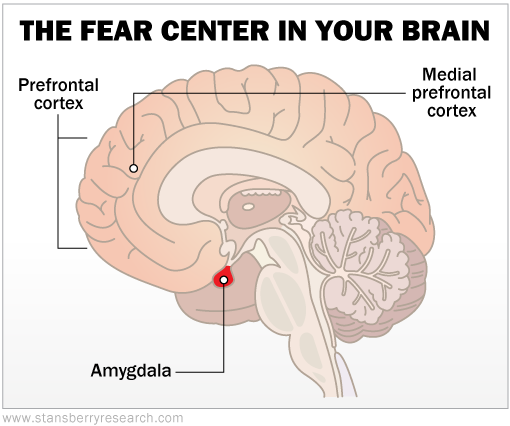My Favorite Way to Conquer Pandemic Fears
A worldwide pandemic... Massive shutdowns... Sky-high unemployment, and a rocky economic outlook... Stock market plunges... Violent protests across the country... Wildfires burning all of the West coast...
2020 is a year ruled by fear.
It's easy to find yourself scared right now. And you're not alone... We've written before about soaring rates of depression, anxiety, and other feelings of worry and fear.
But what do you really know about fear?
Our body's natural fear response comes from the amygdala. It's a tiny, walnut-sized area of the brain known as the fear center.

The prefrontal cortex of our brain (including a region inside of that called the medial prefrontal cortex) regulates the activity of the amygdala.
Your amygdala also gets feedback from your senses. And if it encounters anything out of the ordinary, it triggers a threat response. This is the "fight or flight" response – do you run away from the threat or do you stand and fight it?
This worked great for our prehistoric ancestors. When a saber-toothed tiger springs from the underbrush... you want to snap into action.
But our fight-or-flight instinct isn't calibrated for the "threats" in our modern lives. A crashing stock market fires up our brain's fear center just like a predator's attack does. But it requires a very different response...
Dr. Hans Selye came up with a pioneering theory of stress response back in the 1950s. Under his General Adaptation Syndrome ("GAS"), the first stage is alarm reaction. That's when our amygdala turns on and floods our bodies with adrenaline and cortisol. This creates a burst of energy to deal with the threat.
The second stage is resistance. This is a recovery stage. If the threat continues for a longer period of time, your sympathetic system slows down. You resume some functions like digestion again.
But you're still on "high alert," tapping your energy reserves so you're ready to jump back to alarm if needed. Your body still has surges of cortisol and your blood pressure remains high. This is taxing on your body, so at this stage, you may feel irritable and struggle to concentrate.
The third stage is the exhaustion stage. This is when your body's energy reserves are depleted, and you feel burned out. This stage involves chronic, unrelenting stress that leads to anxiety, depression, and fatigue. This drag on your body weakens your immune system, which makes it harder to fight off bacteria and viruses, so you're more likely to get sick.
Right now, psychologists warn that we're facing a wave of "crisis fatigue." We're all running around stuck in this exhaustion phase. Our brains are overworked, and all that cortisol is damaging our bodies. We're dangerously close to burning out.
The best way to prevent crisis fatigue is to calm our amygdalae.
My favorite way to do this: Meditation.
Longtime subscribers know that one of my favorite practices is meditation. That's because meditation calms activity in the amygdala, which lowers stress levels by boosting serotonin and dopamine levels.
Meditation also activates the vagus nerve. This important nerve cluster sets off the parasympathetic nervous system and controls a lot of activities associated with rest (like our "rest and relax" system that balances our fight-or-flight response). You can start meditating with just 10 minutes a day of silence.
Try out other relaxation techniques, too. Deep breathing using your diaphragm muscle helps calm you down. That's because your diaphragm connects to your amygdala. Try these two breathing exercises:
The 4-7-8 method. Inhale through your nose for a count of four. Hold your breath for a count of seven. Then exhale through your mouth for a count of eight. Do this cycle four times.
Count your breaths. You can also go for a longer period and count your breaths. Always count as you exhale. Take five breaths and then start over with "one" again. Don't go over five. This is a good way to keep your focus – if your thoughts become distracted, you'll find yourself counting past five. Set a time to do this simple breathing meditation for at least 10 minutes.
Try an app. My team and colleagues have tried several meditation apps to help them find some peace. They recommend Calm, Headspace, Insight Timer, and Stop, Breathe & Think.
Meditation is one of my favorite tips, but I have four more to help calm your brain and conquer fear. You can read the rest in my June issue of Retirement Millionaire, here. And if you aren't a subscriber yet, find out how to sign up today for immediate access.
What We're Reading...
- Did you miss it? More on the mental health crisis of COVID-19.
- Something different: Well, this didn't take long...
Here's to our health, wealth, and a great retirement,
Dr. David Eifrig and the Health & Wealth Bulletin Research Team
September 15, 2020